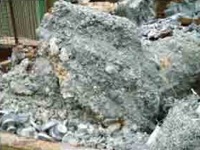Dross
Origin
Middle English dros, from Old English drōs dregs
The term dross derives from the Old English word dros, meaning the scum produced when smelting metals. By the 15th century it had come to refer to rubbish in general. Dregs and the geological term druse are also thought to be etymologically related. Metallurgical dross is referenced as a metaphor for worthless material in the Bible and in other religious texts.
Definitions
Description
Dross is a mass of solid impurities floating on a molten metal or dispersed in the metal, such as in wrought iron. It forms on the surface of low-melting-point metals such as tin, lead, zinc or aluminium or alloys by oxidation of the metal(s).
With wrought iron, hammering and later rolling, removed some dross. With tin and lead the dross can be removed by adding sodium hydroxide pellets, which dissolve the oxides and form a slag. Dross can also be skimmed off.
Dross, as a solid, is distinguished from slag, which is a liquid. Dross product is not entirely waste material; aluminium dross, for example, can be recycled and is used in secondary steelmaking for slag deoxidation.
